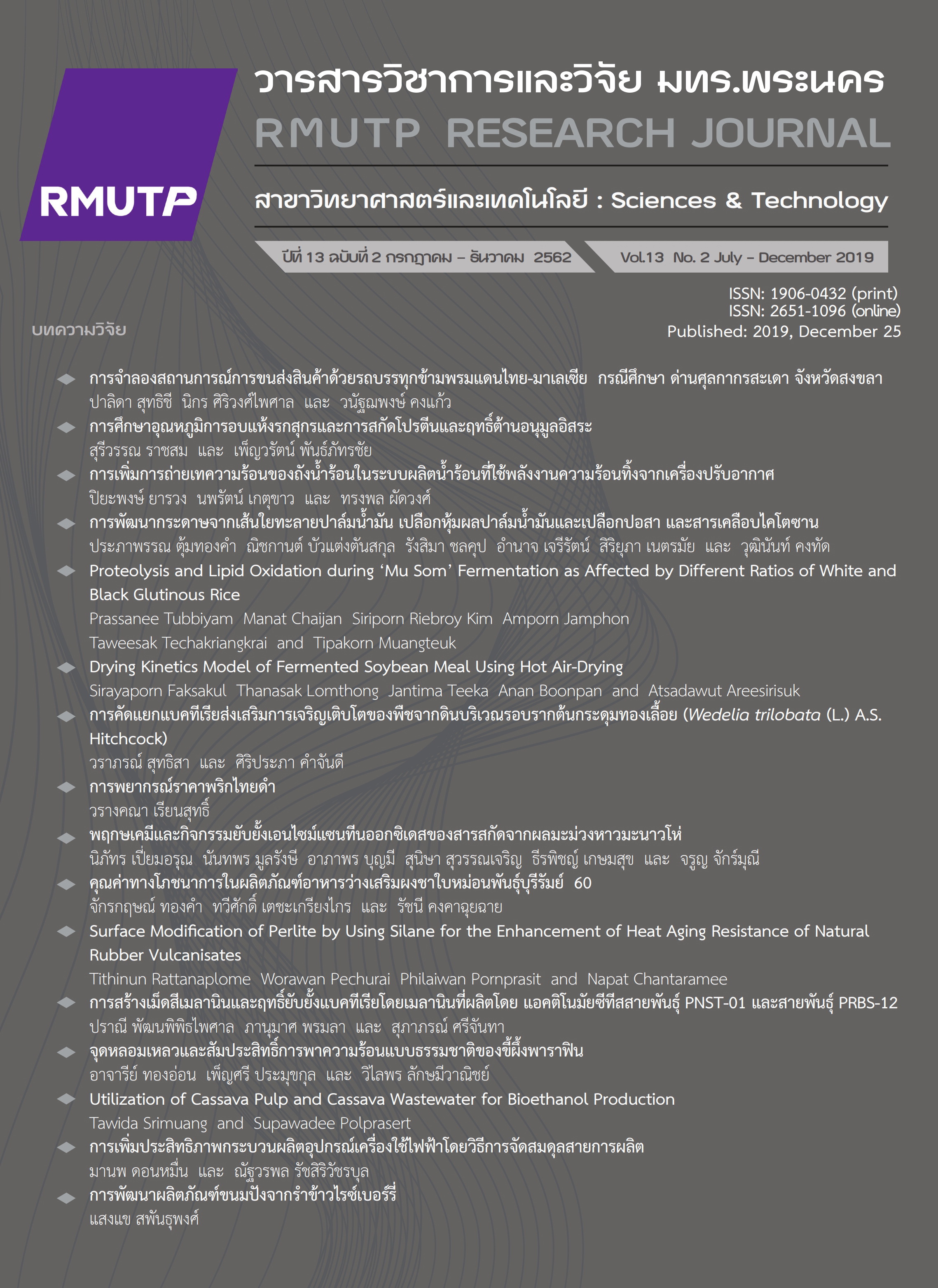Study of Drying Condition and Extraction Process of Protein and Antioxidants from Porcine Placenta
Main Article Content
Abstract
This research aims to study the appropriate drying condition and extraction solvent for extracting protein and antioxidants from the porcine placenta. Three levels of drying temperature were used in this study which were 50, 60 and 70oC, the result shows that the best drying condition for porcine placenta was 70oC for 4 hours because this condition provided the least drying time and the lowest moisture content of porcine placenta (3.80±3.36% dry basis). After that, the fresh and dried porcine placenta were extracted by using three solvents which were deionized water (DI), phosphate buffered saline (PBS) and hexane. The efficiency of extraction was investigated by measuring the crude protein and antioxidant of the porcine placenta. It was found that there was no protein and antioxidant in fresh and dried porcine placenta extracted by hexane. However, the protein was found as 0.05±0.01 and 0.04±0.01 mg of bovine serum albumin/100 mg fresh for fresh porcine placenta and 0.12±0.030 and 0.07±0.016 mg of bovine serum albumin/100 mg fresh for dried porcine placenta extracted by DI and PBS, respectively. In additional, the antioxidant was found as 1.13±0.03 and 1.29±0.04 mg of trolox/100 mg fresh for fresh porcine placenta and 3.37±0.02 and 3.59±0.01 mg of trolox/100 mg fresh for dried porcine placenta extracted using DI and PBS, respectively.
Article Details
References
[2] W. Phuapradit, B. Chanrachakul, P. Thuvasethakul, S. Leelaphiwat, S. Sassanarakkit, and S. Chanworachaikul, “Nutrients and hormones in heat-dried human placenta,”Journal of the Medical Association of Thailand, vol. 83, no. 6, pp. 690-694, 2000.
[3] B. Y. Kim, T. G. Kim, W. Y. Kang, H. Baek, H. Y. Cheon and D. U. Kim, “Functional cosmetic effect of porcine placenta,” Korean Chemical Engineering Research, vol. 48, no. 3, pp. 327-331, Jun. 2010.
[4] C. Yoshikawa, F. Takano, Y. Ishigake, M. Okada, S. Kyo, N. Suzuki, K. Sugiura and K. Koike, “Effect of porcine placental extract on collagen production in human skin fibroblasts In Vitro,” Gynecol Obstet, vol. 3, no. 6, pp. 1-4, Nov. 2013.
[5] W. Tang, M. Zhang and Z. Fang, “Optimization of ultrasound-assisted-extraction of porcine placenta water-soluble proteins and evaluation of the antioxidant activity,” Journal of Food Science and Technology, vol. 52, no. 7, pp. 4042-4053, Jul. 2015.
[6] D. W. Gu, M. J. Kim, M. G. Gwak, H. J. Cho and H. S. Lee, “A method for preparing pig placental extract to use as a feed additive and use thereof,” Patent WO2008002005A1, Jan. 2008.
[7] O. Ruksounjik, S. Klaynongsruang, C. Hahnvajanawong and W. Khunkitti, “Bioactivities of goat placenta hydrolysates,” Isan Journal of
Pharmaceutical Sciences, vol. 12, no. 3, pp. 61-71, 2016.
[8] A. Jash et al., “Topical application of porcine placenta extract inhibits the progression of experimental contact hypersensitivity,” Journal of
Ethnopharmacology, vol. 133, no. 2, pp. 654-662, Jan. 2011.
[9] S. H Park, J. H. Kim, S. G. Min, Y. J. Jo and J. Y. Chun, “Effects of Ethanol Addition on the Efficiency of Subcritical Water Extraction of Proteins and Amino Acids from Porcine Placenta,” Korean journal for food science of animal resources, vol. 35, no. 2, pp. 265-271, Apr. 2015.
[10] N. Mahey, D. Arwapark and D. Pichairatana, “Optimization of high protein hydrolysate extraction from hard clam (Meretrix casta) using response surface methodology,” KKU science journal, vol. 43, no. 3, pp. 425-438, 2015.
[11] M. W. Noall, H. A. Salhanick, G. M. Neher and M. X. Zarrow, “Method for the isolation of progesterone from human placentae,” Journal of Biological Chemistry, vol. 201, pp. 321-328, 1953.
[12] O. H. Lowry, N. J. Rosebrough, A. L. Farr and R. J. Randall, “Protein measurement with the folin phenol reagent,” Journal of Biological Chemistry, vol. 193, no. 1, pp. 265-275, Nov. 1951.
[13] R. Re, N. Pellegrini, A. Proteggente, A. Pannala, M. Yang and C. R. Evans, “Antioxidant activity applying an improved ABTS radical cation
decolorization assay,” Free Radical Biology and Medicine, vol. 26, pp. 1231-1237, May 1999.
[14] A. Jang, C. Jo, I. J. Kim and M. Lee, “Nutritional quality of dried pig placenta,” Journal of Food Science and Nutrition, vol. 12, pp. 89-94, Jun. 2007.
[15] J. Kunwisana, S. Prachayawarakorn and S. Soponronnarith, “Effect of drying temperature on volatile compounds and physical qualities of banana slices,” KMUTT Research and Development Journal, vol. 30, no. 4, pp. 611-621, 2007.
[16] S. Tirawanichakul, S. Lamaepae and Y. Tirawanichakul, “Combined infrared/ microwave and hot air drying for jackfruit: Kinetics quality sensory analysis,” Burapha Science Journal, vol. 17, no. 1, pp. 117-129, Jan. 2012.
[17] S. Tirawanichakul, W. Naphatthalung and Y. Tirawanichakul, “Drying strategy of shrimp using hot air convection and hybrid infrared radiation/hot air convection,” Walailak Journal of Science and Technology, vol. 55, no. 1, pp. 77-100, Jan. 2008.
[18] C. Supakorn and S. Thongpassno, “Effect of Dried Porcine Placenta on Growth Performance in Post-Weaning Pigs,” Walailak Journal of Science and Technology, vol. 8, no. 2, pp. 167-173, Jun. 2011.
[19] A. Sae-Khow, S. Tirawanichakul and Y. Tirawanichakul, Effect of drying with heat convection and heat radiation on drying kinetics and quality aspect of black pepper,” Burapha Science Journal, vol. 18, no. 1, pp. 166-180, Jan. 2013.

